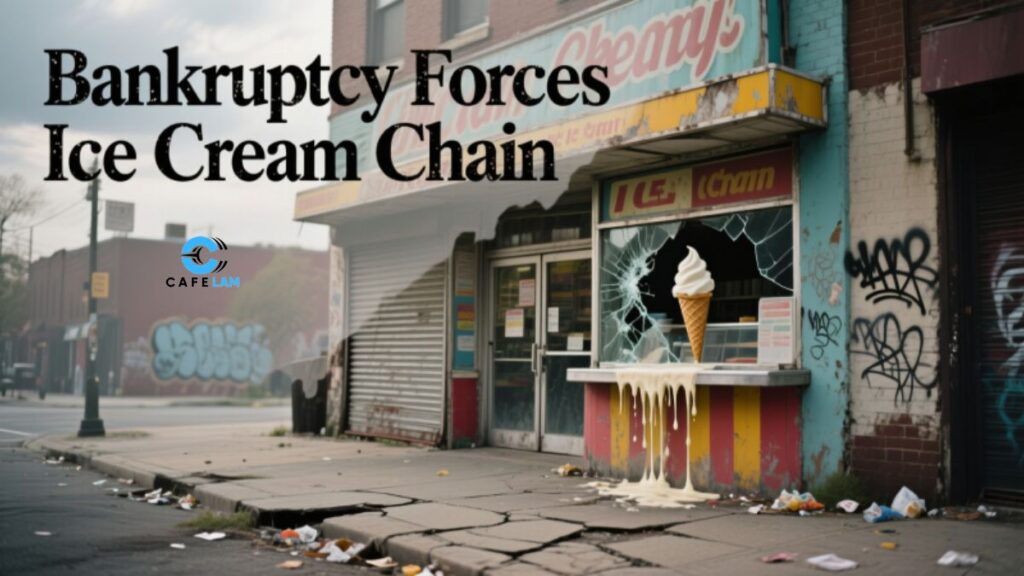The Sweet End of an Era
The retail landscape has witnessed another casualty as bankruptcy forces ice cream chain to close 500 locations across the United States. Thrifty Ice Cream, a beloved brand that has served communities for decades, finds itself caught in the financial turmoil of its parent company, Rite Aid. This closure represents more than just the end of ice cream counters in pharmacies—it symbolizes the changing face of American retail and the ripple effects of corporate bankruptcies.
The announcement sent shockwaves through communities where Thrifty Ice Cream had become a cherished local tradition. Families who grew up enjoying cylindrical scoops and unique flavors now face the reality that their neighborhood ice cream destination may disappear forever. This situation illustrates how corporate financial decisions can have far-reaching impacts on local communities and consumer experiences.
Understanding the Bankruptcy Behind the Closures
Rite Aid’s Chapter 11 bankruptcy filing in October 2023 set the stage for widespread store closures and operational restructuring. The pharmacy giant, struggling with mounting debt and intense competition from larger rivals, made the difficult decision to shutter hundreds of underperforming locations. Unfortunately, these closures directly impact the Thrifty Ice Cream counters housed within these stores.
The bankruptcy process requires companies to evaluate all aspects of their operations and eliminate unprofitable segments. While Thrifty Ice Cream itself wasn’t necessarily losing money, its dependence on Rite Aid’s retail footprint made it vulnerable to the parent company’s financial struggles. This situation demonstrates how interconnected business relationships can create unexpected casualties during corporate restructuring.
Financial analysts point to several factors contributing to Rite Aid’s bankruptcy, including overwhelming debt burdens, decreased foot traffic in physical retail locations, and increased competition from online pharmacies and larger chains. The company’s inability to adapt quickly enough to changing consumer behaviors ultimately led to this dramatic restructuring effort.
Stick around and explore more articles that might catch your interest!
The Rich History of Thrifty Ice Cream
Thrifty Ice Cream has been serving customers since 1940, building a loyal following with its unique cylindrical scooping method and distinctive flavors. The brand became synonymous with affordable, quality ice cream served in an accessible retail environment. Over the decades, Thrifty Ice Cream developed into a cultural icon, particularly in California and other western states where Rite Aid had a strong presence.
The chain’s success stemmed from its innovative approach to ice cream retail within pharmacy settings. Customers could pick up prescriptions while treating themselves to a cone or sundae, creating a convenient and enjoyable shopping experience. This model worked exceptionally well for families, as parents could handle errands while children enjoyed ice cream treats.
Thrifty’s signature rectangular scoop shape became instantly recognizable to generations of customers. The brand offered unique flavors that weren’t available elsewhere, creating a sense of exclusivity and nostalgia. Many customers developed emotional connections to specific flavors and locations, making the current closure announcements particularly painful for communities.
Impact Analysis: Who Gets Affected When Bankruptcy Forces Ice Cream Chain to Close 500 Locations
The closure of 500 Thrifty Ice Cream locations creates a multifaceted impact across various stakeholders. Understanding these effects helps illustrate the broader consequences of corporate bankruptcies beyond simple business metrics.
Community Impact Assessment
| Affected Group | Primary Impact | Long-term Consequences |
| Local Communities | Loss of gathering place | Reduced social connections |
| Families with Children | Fewer affordable treat options | Changed shopping routines |
| Senior Citizens | Loss of familiar shopping destination | Disrupted daily routines |
| Local Employment | Job losses for ice cream counter staff | Reduced local employment opportunities |
| Commercial Property | Vacant retail spaces | Potential property value decline |
Employee Displacement and Job Market Effects
The closure directly affects thousands of employees who worked at Thrifty Ice Cream counters within Rite Aid stores. These workers, many of whom were part-time employees, suddenly find themselves searching for new employment opportunities. The job market impact extends beyond immediate job losses, as these workers compete with others in similar retail positions.
Many affected employees had developed specialized skills in ice cream preparation, customer service, and inventory management specific to the Thrifty brand. While these skills are transferable, finding comparable positions with similar pay and benefits may prove challenging, particularly in smaller communities where Rite Aid was a major employer.
Supplier and Vendor Consequences
The closure announcement also affects suppliers and vendors who provided products and services to Thrifty Ice Cream operations. Dairy suppliers, equipment manufacturers, and logistics companies that depended on this business relationship must quickly adjust their operations and find alternative customers to replace lost revenue.
Financial Restructuring and Asset Liquidation Process
When bankruptcy forces ice cream chain to close 500 locations, the legal and financial processes involved are complex and time-consuming. Chapter 11 bankruptcy allows companies to restructure their debts while continuing operations, but it often requires difficult decisions about which assets to keep and which to eliminate.
Rite Aid’s restructuring plan prioritizes profitable pharmacy operations while eliminating ancillary services that don’t contribute significantly to the bottom line. This strategy, while financially logical, eliminates beloved community amenities like ice cream counters that provided additional value to customers beyond pharmaceutical services.
The liquidation process involves selling equipment, disposing of inventory, and terminating lease agreements for closed locations. This process must be completed efficiently to maximize recovery for creditors while minimizing ongoing operational costs. Unfortunately, this business-focused approach doesn’t account for the emotional and community value that Thrifty Ice Cream provided to customers.
Market Competition and Industry Trends
The closure of Thrifty Ice Cream locations reflects broader trends in retail consolidation and changing consumer preferences. The ice cream industry itself remains strong, but traditional retail models face increasing pressure from specialized shops, food trucks, and direct-to-consumer delivery services.
Consumers increasingly prefer experiential retail environments that offer unique products and personalized service. While Thrifty Ice Cream provided nostalgic value, its pharmacy-based locations couldn’t compete with dedicated ice cream shops that offer extensive flavor selections, customization options, and Instagram-worthy presentations.
The rise of premium ice cream brands and artisanal producers has also changed consumer expectations. Many customers now prioritize quality over convenience, preferring to visit specialized establishments rather than grabbing ice cream during routine errands. This shift in preferences contributed to declining sales at pharmacy-based ice cream counters.
Should you wish to explore other topics, head to our main blog. We’ve got more!
Potential Solutions and Alternative Outcomes
Despite the widespread closures, some industry experts believe alternative business models could preserve the Thrifty Ice Cream brand and legacy. Franchise opportunities, licensing agreements, or partnerships with other retail chains could potentially save some locations and maintain the brand’s presence in affected communities.
Independent franchisees might find opportunities to acquire Thrifty Ice Cream branding and equipment to establish standalone locations in high-traffic areas. This approach could preserve the brand’s unique characteristics while providing more flexibility to adapt to local market conditions and customer preferences.
Strategic partnerships with grocery stores, convenience stores, or entertainment venues could also provide new homes for Thrifty Ice Cream operations. These partnerships would need to maintain the brand’s distinctive qualities while fitting into new retail environments that serve different customer bases and shopping patterns.
Community Response and Preservation Efforts
Many communities affected by the closures have organized grassroots efforts to preserve their local Thrifty Ice Cream traditions. Social media campaigns, petition drives, and community meetings demonstrate the strong emotional connections that customers developed with these ice cream counters over the years.
Some communities are exploring options to purchase equipment and maintain ice cream service through local businesses or community organizations. These efforts face significant challenges, including securing proper permits, finding suitable locations, and managing ongoing operational costs without corporate support.
Local governments and economic development organizations recognize the cultural value of preserving these community gathering places. Some are investigating ways to support transition efforts or attract replacement businesses that can serve similar social functions within their communities.
Looking Forward: Lessons from the Closures
The situation where bankruptcy forces ice cream chain to close 500 locations offers important lessons about business resilience, community value, and the interconnected nature of modern retail operations. Companies that depend heavily on single distribution channels or parent organizations face significant risks when those relationships change unexpectedly.
Future business models in the ice cream industry will likely emphasize operational independence and diversified revenue streams. Successful ice cream businesses will need to balance nostalgic appeal with modern consumer expectations while maintaining financial sustainability without depending on external corporate relationships.
This closure also highlights the importance of community engagement in business preservation efforts. Companies that build strong local connections and demonstrate clear community value are more likely to receive support during difficult transitions and find alternative solutions when traditional business models fail.
Conclusion
The closure of 500 Thrifty Ice Cream locations represents more than a simple business restructuring—it marks the end of a cultural institution that brought joy to countless families and communities. While financial realities necessitated these difficult decisions, the impact extends far beyond corporate balance sheets to affect real people and neighborhoods.
As communities adapt to these changes, opportunities may emerge for new businesses to fill the void left by Thrifty Ice Cream’s departure. The challenge will be maintaining the accessibility, affordability, and nostalgic charm that made the original brand so beloved while building sustainable business models for the future.
Frequently Asked Questions
Q: Will any Thrifty Ice Cream locations remain open after the bankruptcy?
A: Some locations within surviving Rite Aid stores may continue operating, but the majority of the 500 affected locations will close permanently.
Q: Can customers still buy Thrifty Ice Cream products in grocery stores?
A: Yes, Thrifty Ice Cream products remain available in grocery stores as the bankruptcy primarily affects in-store scoop counters, not packaged retail products.
Q: How long will the closure process take for affected locations?
A: Most closures are expected to be completed within 6-12 months as part of Rite Aid’s overall restructuring timeline.
Q: Are there plans to sell the Thrifty Ice Cream brand to another company?
A: While possible, no official announcements have been made regarding the sale of the Thrifty Ice Cream brand to other operators.
Q: Will employees receive severance packages or assistance finding new jobs?
A: Severance benefits vary by location and employee status, with some workers eligible for job placement assistance through Rite Aid’s restructuring programs.






